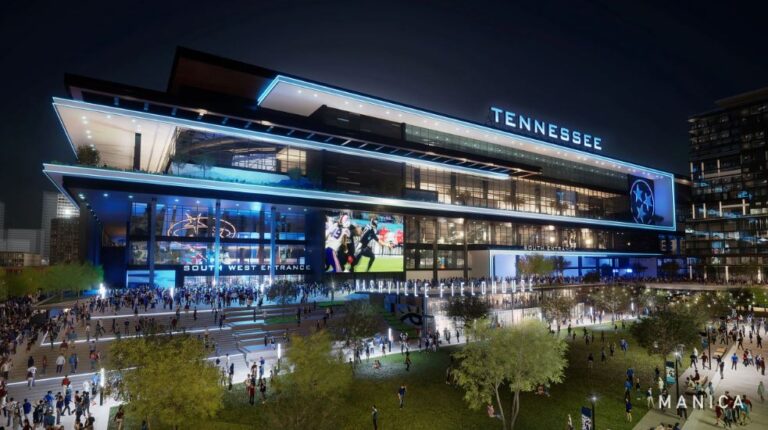The Tennessee Titans new stadium financing structure (livestream at Zennie62 YouTube, above) has a lot in common with that of Cowboys Stadium, Levi’s Stadium where the 49ers play, the Atlanta Falcons’ Mercedes Benz Stadium, the Las Vegas Raiders’ Alligient Stadium, U.S. Bank Stadium AKA “The Ship” of The Minnesota Vikings, and the L.A. Rams SoFi Stadium, to name most of the sports organizations employing the public-private approach. Let’s take a look at the Tennessee Titans version of the emerging stadium ownership approach.

The Tennessee Titans are building a $2.1 billion, 1.7 million square feet, 62,000 seat new stadium to be located next to the current Nissan Stadium located on the east bank of the Cumberland River. Once the new Tennessee Stadium is finished in 2025, the Nissan Stadium will be demolished.
All of this is possible in large part because of a financing model that’s become an NFL standard with each new stadium. It features a stadium authority that owns the facility and floats the bonds to be issued to pay for all or part of the edifice’s construction, while the team is the owner of an organization called in the legal documents “Stad-Co” and is the manager of the stadium for the stadium authority.
Stad-Co Equals Big Money For NFL Organizations Like The Titans And Soon MLB’s Oakland A’s In Las Vegas
This financing structure is a modernized variation of the old model of public ownership, but it’s effectively a joint-venture between the public sector and the private sector, or city and county on the government side, and NFL team (or MLB team) on the private side.
In the Titans case, the owner of the stadium is called The Sports Authority of The Metropolitan Government of Nashville and Davidson County. Meanwhile, the operator of the Tennessee Stadium (no naming rights partner has been announced other than the State of Tennessee itself) is called Tennessee Stadium LLC, and is a new LLC started by the Titans themselves, and in an approach much like that for the Raiders, 49ers, Falcons, and the other organizations named at the start of this article. The basic idea of the structure is to allow each team to gain the revenue from all events in the facility (like concerts and car shows), not just for football for the Titans, Cowboys, Vikings, Raiders, Niners and Falcons, or baseball in the case of the Athletics.
The advantage of the arrangement is multifaceted for the team organization. First, it shields the Titans from paying a property tax since the NFL team doesn’t own the facility. Second, as mentioned, the team organization enjoys all revenues from the stadium. (As then NFL Executive Vice President Eric Grubman explained it to me at the 2016 NFL Fall Owners Meeting in Houston, and in response to my question why the Raiders Las Vegas stadium would be publicly owned whereas the Raiders wanted private ownership in Oakland, “Zennie, if I own the revenue from the stadium, isn’t that the same as owning the stadium?”)
Another advantage is that the team is effectively shielded from any insurance costs since it doesn’t own the stadium, thus the stadium authority bears those costs. That’s not to say that StadCo can escape liability for such occurences as slip-and-falls, and Broncos LB Aaron Patrick’s current lawsuit is shaping up to provide a kind of stress-test of the StadCo model. But the structure’s objective was less about escape from slip and falls and more about collecting money from various stadium uses and having that go to the team. And with that, we turn to a look at the specific financing breakdown for the Tennessee Titans’ Tennessee Stadium.
The financing for the Titans New Stadium looks like this:
What The Tennesee Titans New Stadium Financing Looks Like In A Nutshell
The totals for Stadium Construction are as follows:
Stadium Authority: $760 million
Stad-Co (AKA Titans): $840 million
State of Tennessee: $500 million
Total Contributions: $2.1 billion.
The Titans $840 million is further broken down into the following primary sources: personal seat license revenues, NFL G-4 Loan contribution (anticipated here to be $250 million), and proceeds from investment funds. As StadCo, the Titans also pledged to pay all stadium construction cost overruns. Also, the stadium lease is the standard of 30 years, same as that for the other NFL teams mentioned. In addition, the call for the signing of a non-relocation agreement is a requirement as part of Tennesee Stadium financing.
Tennesee Stadium Model Places Nashville As Stadium Authority Backstop
The 562-page preliminary bond issue for the four types of bonds (and the primary source of information for this article), also points to the Nashville Metropolitan Government as the place where its general fund serves as a backstop for the pledged revenue bonds. In turn, the taxable bonds are paid for by a 1 percent county wide hotel tax, a stadium sales tax, a ticket tax, and what are called Water & Sewer PILOT (Payment in Lieu of Taxes) revenues. Meanwhile, the non-taxable bonds
In Closing, Tennesee Stadium Financing Model Reflects’ State’s Enthusiasm For The Project
In all, this author must state that the Tennesee Stadium Financing Model reflects Nashville, and indeed, the State of Tennesee’s desire to see the $2.1 billion NFL stadium come to life. Arrangements that would be controversial anywhere else (like Oakland or Las Vegas) like Nashville committing itself as backstop for the payment of revenue bonds, are taken as a necessary thing that must be done to get the building built. While no effort is perfect, this one does come close.
Stay tuned.
